- Why and how is Onam celebrated? Author
laments that today people prefer to watch celebrations on TV/Phones rather than
doing and enjoying themselves.
Onam, the festival brings in the most cherished festivities to the God's own iand, Kerala. Kerala Tourism Department Corporation has coined this in their publicity jargons and to a great extent it has succeeded in its mission also.
But the true attribute of Godliness stretches back to our Puranas wherein there is 'reference to the Sage Jamadagni and his son Parashurama, who on the command of his infuriated father, beheaded his own mother, Renuka and later as repentance vowed to annihilate the entire clan of Kshatriyas, because the root cause for that development was one Kshatriya, and started rehabilitating the Brahmins in the territory captured from the Kshatriyas. When the land ran short, he pleaded to Varuna, the lord of the seas and flung his mighty axe deep over the sea and he achieved to reclaim the land till the limit of the Place where his axe fell, and the same was distributed among the Brahmins. Legends have it that the land so reclaimed is none other than Kerala. It is interesting to read that many other territories also claim the same story right from the land of Saurashtra to Karnataka as well. Whatever may be the claims, Kerala is fondly known as Bhargovakshetra.
This article was first published in the Bhavan’s Journal.
That is one side of the story. The other
one takes us a step further backwards, to the incarnation of Lord Vishnu as the
dwarf, Vamana. It was in this blessed land that the best administrator and the ruler, Raja Bali reigned over his darling Prajas. Folk-lore ballads starts, among other things, with “during the reign of Maveli (Mahabali), all men were alike (true proletarianism), no treachery, no cheating, no forgery, no double standards (measures), no malpractices.”
Mahabali’s rule was of such a high acclaim and admiration from the masses, and from far flung Places, that though being an Asura, the Gods started feeling envious about his achievements. In the process Raja Bali also became a bit swellheaded that he developed a certain degree of ego in him that he was the best and he could donate anything that is demanded! The fame of the Gods was at stake now. It was a well-established fact that Maveli was very hospitable and generous and would give away whatever was demanded of him. Then Lord Vishnu chalked out a Plan to overcome this difficulty as well.
It was to this effect that He took the incarnation of Vamana, a miniature dwarf Brahmachari who was wandering as a Bhikshu. One fine morning he called on at Maveli's court and was received with warm regards and with full honour and elaborate hospitality. It was customary for the king to enquire about the well being and offer some special gift (Bhiksha) when the honoured guest was parting.
The wise guru of, the demons, Shukra,
sensed something fishy in the strange happenings and alerted the king to be
very careful and cautious about any commitment. In his high abandon, Maveli did
not suspect anything unusual and he was casual enough to offer anything he
asked for. The mendicant said he did not wish to have anything great other than
a mere three feet space of land on which he could meditate peacefully. Maveli
granted it immediately referring to the demand as very silly.
Before solemnizing the gift a formal
ritual was to be carried out by offering holy water through a kindi pot with its characteristic spout,
Shukra tried to safeguard the king, by obstructing the ritual, by blocking the
spout with his own diminished physical body as he had the capacity of changing
his own appearance and shape at his will. Vamana realized the cause of the
blockage and to clear the water passage, he took a blade of Darbha grass and
poked it in and out. There arose a scream from the tail and out came
Shukracharya with a bleeding eye but the ritual was accomplished. He had to pay
a heavy price, one eye, for coming in the way of Gods.
Vamana now sought permission to acquire the committed land by his foot measurement, which was immediately granted. Now, to Maveli's surprise, the dwarf started growing bigger and bigger. Maveni realized the truth. Vamana covered the entire earth by His first step; the second step equalled the sky. Then he asked where to keep the third step as no other place was in sight. To this, with due prostration Maveli offered his head only to be pushed down to the Patal.
But before carrying out that deed he pleaded to Lord Vishnu that he be given
the boon to revisit his beloved Prajas
once a year to reminisce his good days
with them.
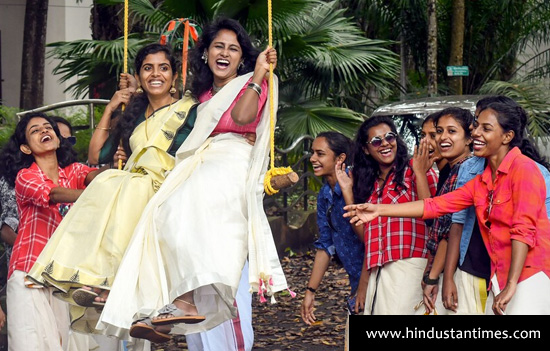 Onam is happiness and family time. All smiles.
Onam is happiness and family time. All smiles.
The Bhaktavatsala immediately approved
the request and it is believed that it is on the day of Onam, Year after year, that Maveli visits each and every household of
Keralites (irrespective of caste, creed. or religion) and reassesses the
well being of his darlings.
It is definitely not proper to believe
that Kerala is inhabited by Asuras. Kairali
cherishes the memories of her virtuous sons, the likes of none other
than Adi Shankara, the master reformer and philosopher, Shree Narayana Guru,
the social reformer, Raja Swati Thirunal, the exponent and composer of
classical music, Raja Ravi Varma, the master Painter, Swami Chinmayananda, the
renowned Vedanta guru and many more.
So, Onam time is the State festival for
Malayalees, resident or non-resident in Kerala. It is a time to rejoice and
revel. Being basically a harvest festival, the granaries are full and the season
is also favourable, that being just after the South West monsoons and just
before the next North East one. The lush green canopy and flowers of different
hues, fragrance, shades and shapes aplenty, it is a gay time for the children
to wander in gay abandon all along the green belts, fences and hedges, singing
Onam songs and gathering flowers, the most important one being the Thumba, the characteristic milky blooms peeping
out from thick housing, and filling their reed baskets hung from the shoulders.
The season abounds in the clusters of dragonflies (lovingly called as Onathumpy) hovering over small pools for
laying their ebbs, while groups of butterflies prefer the garden and orchards
for having a feast of pollens and honey, yet another variety of winged artists
is never in the background.
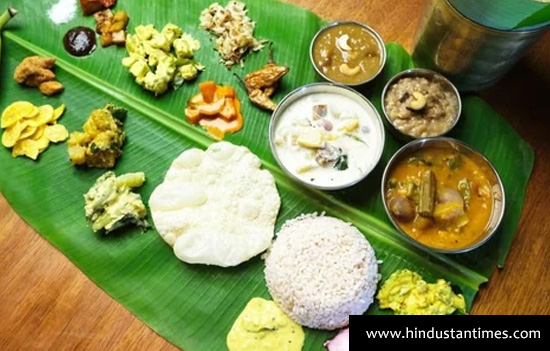 “A traditional Onam sadhya consists of around 24-26 dishes in total, covering all kinds of tastes.” Credits Hindustan Times.
“A traditional Onam sadhya consists of around 24-26 dishes in total, covering all kinds of tastes.” Credits Hindustan Times.
Kerala countryside has enormous diversities of birds, with beautiful colours, some with long tails, some with forked tails, some with coloured crests and Yet some others with sweet and melodious songs. They all appear to be overactive during the Onam time. It becomes very difficult to find out, any single natural entity, which is not enchanting and breathtakingly beautiful in Kerala. Truly, it is "God's own land", probably being spoilt by man!
The flower offering at the courtyard
starts with Athappoo (on the star Hasta), ten days ahead of the star Shravan (Thiru-Onam), when the sun enters the constellation of Leo, for
Malayalees. (Thiru is the Dravidian equivalent of Shree). The finale is in the wee hours of the Onam day-break
when all the family members gather together and ceremoniously decorate Mathevar with typical palm leaf umbrella
and offer the flowers with lots and lots of Poovilis
(adorations) to Maveli.
It is a family reunion time. Uncountable
variations of celebrations in cultural, sports and games follow, each having
its own degree of uniqueness and identity.
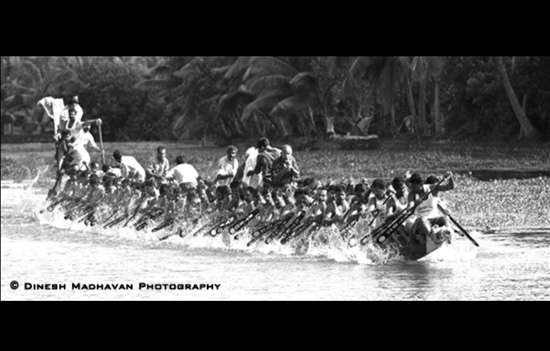 Boat race Kerala.
Boat race Kerala.
The famous boat races of Kayamkulam and
Aranmula are ferociously fought, Year after year, much to the pleasure, surprise
and amusement of the thousands of visiting tourists.
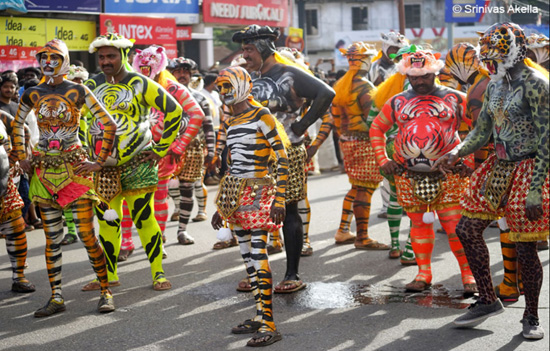 Pulikali (tiger dance) festival Onam at Thrissur is celebrated on the 4th
day of Onam.
Pulikali (tiger dance) festival Onam at Thrissur is celebrated on the 4th
day of Onam.
Characteristic Malayalee art forms like
Kathakali, Mohiniattarn, Koodiattam, Koothu, Ottanthullal, Theyyam, Kavadi
dances and Villadichan-Pattu etc. are staged at numerous locations apart from
the routine dances, songs and dramas.
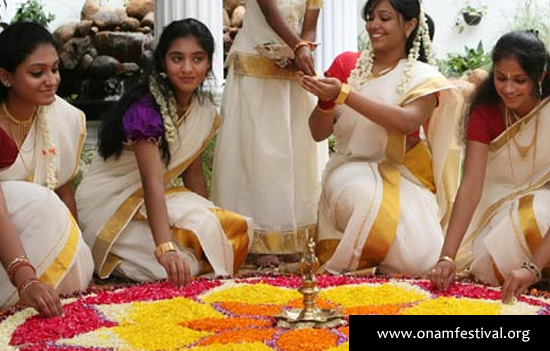 Flower lay-outs during Onam.
Flower lay-outs during Onam.
Every nook and corner of the state
conducts Onam flower layout design competitions, which draw lots of
Participants.
Alas! These competitive days, poor children
lack the leisure time to indulge in such memorable festivities. Even in the
remote countryside one can see nowadays, kids with smart uniforms and neckties
ferried across the home and the school in minibuses and Pickups. They hardly
have any time, to step into the lap of Mother Nature, free from their daily
home-works and routines of the day and to enjoy the fineries of life. It is a
pitiable scene to watch children losing their childhood! Even elders resort to
watch the idiot box and get solace in seeing Ouam in its screen.
Well, this is the trend of the time. All
those good days may remain in the memories of a few elders and narrations will
have to be done to the grand kids in the style of our Shrutis and Smritis. But
then, the next calamity is again our fast life
style.
The younger generation is equally drawn to the attractions of internet and the like that they too cannot spare any time for these fineries. One has to be the mute witness to the sight of gradually fading cultural heritage and man's attachment to the Mother Nature and the environment! Pesticides and other farm chemicals play havoc on the feathered beauties of nature.
Onam is for all Malayalees and is
celebrated by all, no matter whether one is a Hindu, Christian or a Muslim. It
extends to four days beyond Shravan as well, the last day all spent flowers and
other offerings are collected and disposed off royally. Keralites keep waiting
for the next visit of their beloved Raja, the next Onam. Schools have vacation;
offices remain closed. Festivities are seen all around. It somewhat resembles
Diwali time in the rest of India, the Christmas time for Europe and USA, and
Golden Week in Japan.
This article was first published in the Bhavan’s Journal, August 31, 2002 issue. This article is courtesy and copyright Bhavan’s Journal, Bharatiya Vidya Bhavan, Mumbai-400007. eSamskriti has obtained permission from Bhavan’s Journal to share. Do subscribe to the Bhavan’s Journal – it is very good.
Also
read
1. To know about each of the 10 days
on Onam
2.
What is ONAM